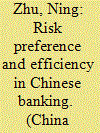| Srl | Item |
| 1 |
ID:
094884


|
|
|
|
|
| Publication |
2010.
|
| Summary/Abstract |
This study explores empirical evidence for two hypotheses through a macro productivity analysis using the nonparametric directional distance function approach applied to the thermal power sector. The first hypothesis is that the marginal abatement cost has significantly declined in recent years mainly due to domestic flue gas desulfurization technology in China, which has become available at a reasonable cost. The second is the existence of a certain budget scale, which, with policy intervention, would have significant outcomes. These hypotheses are successfully addressed through the findings that the marginal abatement cost in 2006 had declined by half since 2003 and that the strategic allocation of 10 billion yuan for SO2 emissions abatement would result in an additional 550,000 tonnes of SO2 reductions.
|
|
|
|
|
|
|
|
|
|
|
|
|
|
|
|
| 2 |
ID:
163523


|
|
|
|
|
| Summary/Abstract |
This paper aims to measure banking efficiency by considering risk preferences in 49 Chinese commercial banks during the period of 2004–2012. It adopts a method which allows for endogenous classification of three risk preferences, namely the conservative, moderate and aggressive risk modes, by changing direction vectors. Banking efficiency is measured on the basis of optimal risk preference. The findings show that the moderate risk preference is the most appropriate strategy to achieve technical efficiency in the Chinese banking sector. However, the aggressive risk preference involving low risk costs, compulsory credit spreads and scale expansion played a critical role in promoting the development of Chinese banking sector, but its effect decreased rapidly. The findings also imply that the average technical efficiency scores of joint stock commercial banks and city commercial banks were higher than those of state-owned commercial banks under the optimal risk preference, and that the measured efficiency mainly shows a trend of improvement over time.
|
|
|
|
|
|
|
|
|
|
|
|
|
|
|
|